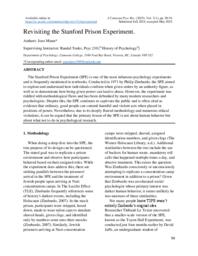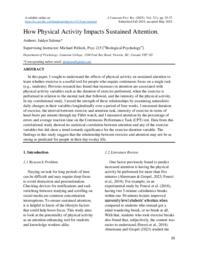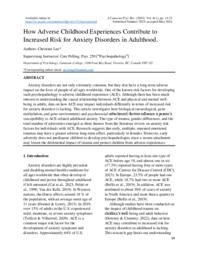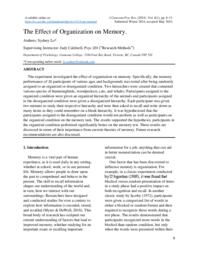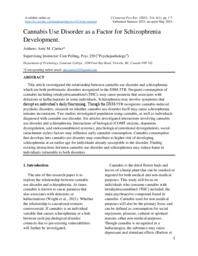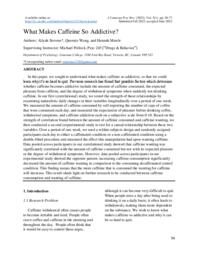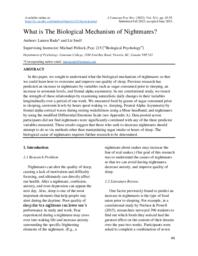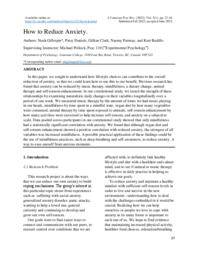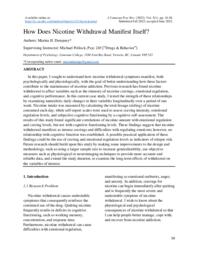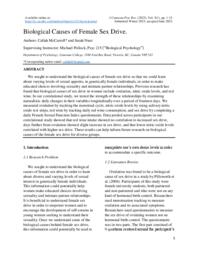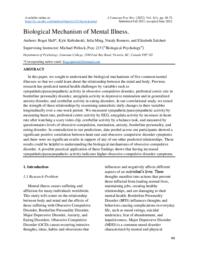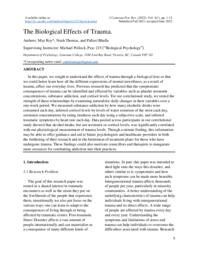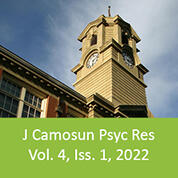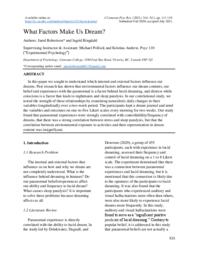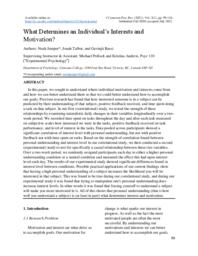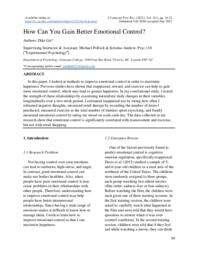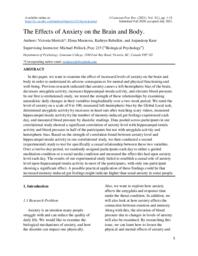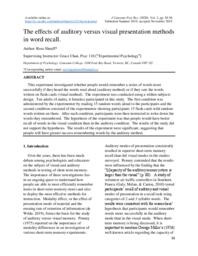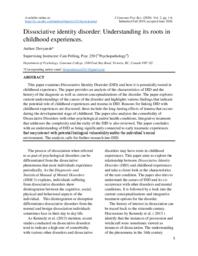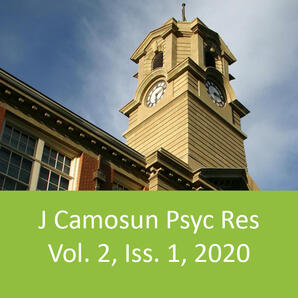article
Related Works
Content type
Digital Document
Description / Synopsis
In this paper, we aim to discover what factors influence memory retention, and how to improve our ability to retain relevant information to recall at a later time. Previous research has predicted levels of memory retention by variables such as the amount of sleep a person has each night, the level of anxiety-depression a person experiences, the level of physical activity someone does each day, and study duration, frequency, and spacing. In our first (correlational) study, we tested the strength of these relationships by examining naturalistic daily changes in their variables longitudinally over one week. We measured sleep by tracking the number of minutes of sleep during each night, and the level of anxiety-depression by tracking heart rate, urine and subjective mood of anxiety-depression. We recorded physical activity by tracking how much exercise we did throughout the day and the intensity of the exercise on a 1-9 scale. For studying we tracked the overall amount of time spent studying, the number of times studying took place, how long each study session was, and how long the space was in between study sessions. Memory retention was tested by our ability to remember at the end of the day a set of 20 randomized words given in the morning. Based on the strength of correlation found between study time and memory retention, we then conducted a second (experimental) study to test for a causal relationship between these two variables. Over eight days we assigned participants on alternating days to have either 3 separate 5-minute study sessions or just 1 single study session and measured the effect this had upon memory and anxiety-depression. Data pooled across participants in our correlational study showed significant correlations of memory retention with anxiety-depression subjective measurements, overall study time, study session frequency, duration, and spacing, but not with sleep amount, heart rate, time spent urinating, nor with physical activity amount and intensity. Data from our experimental study showed that increasing study time caused an enhancement of memory retention, which could not be accounted for by changes in anxiety-depression. Based on our experimental results, we recommend that in order to improve the ability to retain and recall information, more time should be spent studying.
Origin Information
Content type
Digital Document
Description / Synopsis
Anxiety disorders are not only extremely common, but they also have a long-term adverse impact on the lives of people of all ages worldwide. One of the known risk factors for developing such psychopathology is adverse childhood experience (ACE). Although there has been much interest in understanding the causal relationship between ACE and physical and mental wellbeing in adults, data on how ACE may impact individuals differently in terms of increased risk for anxiety disorders is lacking. This article investigates how biological (neurological, gene methylation, and gene-environment) and psychosocial (attachment) factors influence a person’s susceptibility to ACE-related adulthood anxiety. The type of trauma, gender differences, and the total number of adversities emerged as three themes from the literature review on anxiety risk factors for individuals with ACE. Research suggests that early, multiple, repeated emotional traumas may have a greater adverse long-term effect, particularly in females. However, early adversity does not predispose children to develop psychopathologies since a secure attachment may lessen the detrimental impact of trauma and protect children from adverse experiences.
Origin Information
Content type
Digital Document
Description / Synopsis
The experiment investigated the effect of organization on memory. Specifically, the memory performance of 26 participants of various ages and backgrounds was tested after being randomly assigned to an organized or disorganized condition. Two hierarchies were created that contained various species of hummingbirds, woodpeckers, cats, and whales. Participants assigned to the organized condition were given an organized hierarchy of the animals and participants assigned to the disorganized condition were given a disorganized hierarchy. Each participant was given two minutes to study their respective hierarchy and were then asked to recall and write down as many items as they could remember on a blank hierarchy. It was hypothesized that the participants assigned to the disorganized condition would not perform as well as participants on the organized condition on the memory task. The results supported the hypothesis; participants in the organized condition performed significantly better on the memory test. These results are discussed in terms of their importance from current theories of memory. Future research recommendations are also discussed.
Origin Information
Content type
Digital Document
Description / Synopsis
This article investigated the relationship between cannabis use disorder and schizophrenia which are both problematic disorders recognized in the DSM-5TR. Frequent consumption of cannabis including tetrahydrocannabinol (THC), may cause paranoia that associates with delusions or hallucinations in some individuals. Schizophrenia may involve symptoms that disrupt an individual’s daily functioning. Though the DSM-5TR recognizes cannabis-induced psychotic disorders, research on whether cannabis use disorder itself may cause schizophrenia remains inconsistent. Two studies investigated population using cannabis, as well as individuals diagnosed with cannabis use disorder. Six articles investigated interactions involving cannabis use disorder and schizophrenia. Interactions of biological (COMT enzyme, dopamine dysregulation, and endocannabinoid systems), psychological (emotional dysregulation), social (attachment styles) factors may influence early cannabis consumption. Cannabis consumption that develops into cannabis use disorder may contribute to higher risk of developing schizophrenia at an earlier age for individuals already susceptible to the disorder. Finding existing interactions between cannabis use disorder and schizophrenia may reduce harm in individuals vulnerable to both disorders.
Origin Information
Content type
Digital Document
Description / Synopsis
In this paper, we sought to understand what the biological mechanism of nightmares so that we could learn how to overcome and improve our quality of sleep. Previous research has predicted an increase in nightmares by variables such as sugar consumed prior to sleeping, an increase in serotonin levels, and frontal alpha asymmetry. In our correlational study, we tested the strength of these relationships by examining naturalistic daily changes in their variables longitudinally over a period of one week. We measured food by grams of sugar consumed prior to sleeping, serotonin levels by hours spent waking vs. sleeping, Frontal Alpha Asymmetry by frontal alpha cortical waves during resting wakefulness using a Muse headband, and nightmares by using the modified Differential Emotions Scale (see Appendix A). Data pooled across participants did not find nightmares were significantly correlated with any of the three predictor variables measured. These results suggest that those who seek to decrease nightmares should attempt to do so via methods other than manipulating sugar intake or hours of sleep. The biological cause of nightmares requires further research to be determined.
Origin Information
Content type
Digital Document
Description / Synopsis
In this paper, we sought to understand how lifestyle choices can contribute to the overall reduction of anxiety, so that we could learn how to use this to our benefit. Previous research has found that anxiety can be reduced by music therapy, mindfulness, a dietary change, animal therapy and self-esteem enhancement. In our correlational study, we tested the strength of these relationships by examining naturalistic daily changes in their variables longitudinally over a period of one week. We measured music therapy by the amount of times we had music playing in our heads, mindfulness by time spent in a mindful state, vegan diet by how many vegetables were consumed, animal therapy by time spent exposed to animals, self-esteem enhancement by how many activities were exercised to help increase self-esteem, and anxiety on a subjective scale. Data pooled across participants in our correlational study showed that only mindfulness had a statistically significant correlation with anxiety. We found that although vegan diet and self-esteem enhancement showed a positive correlation with reduced anxiety, the strongest of all variables was increased mindfulness. A possible practical application of these findings could be the use of mindfulness practices, such as deep breathing and self-awareness, to reduce anxiety. A way to ease oneself from anxious moments.
Origin Information
Content type
Digital Document
Description / Synopsis
In this paper, I sought to understand how nicotine withdrawal symptoms manifest, both psychologically and physiologically, with the goal of better understanding how these factors contribute to the maintenance of nicotine addiction. Previous research has found nicotine withdrawal to affect variables such as the intensity of nicotine cravings, emotional regulation, and cognitive performance. In this current case study, I tested the strength of these relationships by examining naturalistic daily changes in their variables longitudinally over a period of one week. Nicotine intake was measured by calculating the total dosage (ml/mg) of nicotine consumed each day, while self-report scales were used to assess craving intensity, emotional regulation levels, and subjective cognitive functioning by a cognitive self-assessment. The results of this study found significant correlations of nicotine amount with emotional regulation and craving levels, but not with cognitive functioning levels. These findings suggest that nicotine withdrawal manifests as intense cravings and difficulties with regulating emotions; however, no relationship with cognitive function was established. A possible practical application of these findings could be the use of craving and emotional regulation levels as indicators of relapse risk. Future research should build upon this study by making some improvements to the design and methodology, such as using a larger sample size to increase generalizability, use objective measures such as physiological or neuroimaging techniques to provide more accurate and reliable data, and extend the study duration, to examine the long-term effects of withdrawal on the variables of interest.
Origin Information
Content type
Digital Document
Description / Synopsis
We sought to understand the biological causes of female sex drive so that we could learn about varying levels of sexual appetite, in genetically female individuals, in order to make educated choices involving sexuality and intimate partner relationships. Previous research has found that biological causes of sex drive in women include ovulation, nitric oxide levels, and red wine. In our correlational study, we tested the strength of these relationships by examining naturalistic daily changes in their variables longitudinally over a period of fourteen days. We measured ovulation by tracking the menstrual cycle, nitric oxide levels by using salivary nitric oxide test strips, red wine by tracking daily red wine consumption, and sex drive by completing a daily Female Sexual Function Index questionnaire. Data pooled across participants in our correlational study showed that red wine intake showed no correlation to increased sex drive, days further from ovulation showed slight increase in sex drive, and that lower nitric oxide levels correlated with higher sex drive. These results can help inform future research on biological causes of the female sex drive for diverse groups.
Origin Information
Content type
Digital Document
Description / Synopsis
In this paper, we sought to understand what physiological factors influence state anger in the hopes of improving awareness of potential triggers. Previous research has predicted that an increase in heart rate, hunger, and headache pain intensity all lead to an increase in state anger. In our correlational study, we tested the strength of these relationships by examining naturalistic daily changes in their variables longitudinally over a period of 11 days. We measured heart rate by reading our pulse for one minute three times a day, and we measured our hunger, headache pain and anger levels by using a Likert scale three times a day. For each variable measured, we added the total of their three daily values together to get an average value for each day. Data pooled across participants in our correlational study showed significant positive correlations of anger with hunger and headache pain, and a significant negative correlation with heart rate. These results provide some insight into what individuals might avoid, such as becoming hungry or not treating a painful headache, to decrease the likelihood of becoming angry.
Origin Information
Content type
Collection
Description / Synopsis
ABOUT The Journal of Camosun Psychology Research is a biannual, online student publication produced with the support of the Department of Psychology at Camosun College. All articles are instructor-reviewed and edited. ISSN 2562-5624. RIGHTS INFORMATION Works featured in this journal are CC BY-NC 4.0 (https://creativecommons.org/licenses/by-nc/4.0/). Authors retain all rights to original work. CONTACT Michael Pollock, Faculty Editor pollockm@camosun.ca Camosun College Lansdowne School of Arts & Science 3100 Foul Bay Road Victoria, BC V8P 5J2 lək̓ʷəŋən Territory
Content type
Digital Document
Description / Synopsis
In this paper, we sought to understand the biological mechanisms of five common mental illnesses so that we could learn about the relationship between the mind and body. Previous research has predicted mental health challenges by variables such as sympathetic/parasympathetic activity in obsessive-compulsive disorder, prefrontal cortex size in borderline personality disorder, amygdala activity in depressive rumination and in generalized anxiety disorder, and cerebellar activity in eating disorders. In our correlational study, we tested the strength of these relationships by examining naturalistic daily changes in their variables longitudinally over a one-week period. We measured sympathetic/parasympathetic activity by measuring heart rate, prefrontal cortex activity by EEG, amygdala activity by increases in heart rate after watching a scary video clip, cerebellar activity by a balance task, and measured by questionnaires levels of obsessive-compulsion, rumination, anxiety, borderline personality, and eating disorder. In contradiction to our predictions, data pooled across our participants showed a significant positive correlation between heart rate and obsessive compulsive disorder symptoms and there were no significant results in support of any of our other predicted relationships. These results could be helpful to understanding the biological mechanisms of obsessive-compulsive disorder. A possible practical application of these findings shows that having increased sympathetic/parasympathetic activity indicates higher obsessive-compulsive disorder symptoms.
Origin Information
Content type
Digital Document
Description / Synopsis
In this paper, we sought to understand the effects of trauma through a biological lens so that we could better learn how all the different expressions of mental unwellness, as a result of trauma, affect our everyday lives. Previous research has predicted that the symptomatic consequences of trauma can be identified and affected by variables such as platelet serotonin concentrations, substance addiction, and cortisol levels. For our correlational study, we tested the strength of these relationships by examining naturalistic daily changes in their variables over a one-week period. We measured substance addiction by how many alcoholic drinks were consumed each day, inferred cortisol levels by levels of water retention of the wrist each day, serotonin concentrations by rating tiredness each day using a subjective scale, and inferred traumatic symptoms by heart rate each day. Data pooled across participants in our correlational study showed that alcohol intake, but not serotonin or cortisol levels, was significantly correlated with our physiological measurement of trauma levels. Though a minute finding, this information may be able to offer guidance and aid to future psychologists and healthcare providers in both the furthering of their research and in the betterment of treatment plans for those who have undergone trauma. These findings could also motivate councillors and therapists to inaugurate more resources for combatting addiction into their practices.
Origin Information
Content type
Collection
Description / Synopsis
Journal of Camosun Psychology Research Volume 4, Issue 1, September 1, 2022 ISSN 2562-5624 Managing Editor: Michael Pollock Camosun College, Victoria, BC, lək̓ʷəŋən Territory
Origin Information
Content type
Digital Document
Description / Synopsis
In this paper we sought to understand which internal and external factors influence our dreams. Past research has shown that environmental factors influence our dream contents, our belief and experiences with the paranormal is a factor behind lucid dreaming, and distress while conscious is a factor that leads to nightmares and sleep paralysis. In our correlational study, we tested the strength of these relationships by examining naturalistic daily changes in their variables longitudinally over a two-week period. The participants kept a dream journal and rated the variables and outcomes on one-to-five Likert scales every morning for two weeks. Our study found that paranormal experiences were strongly correlated with controllability/frequency of dreams, that there was a strong correlation between stress and sleep paralysis, but that the correlation between environmental exposure to activities and their representation in dream content was insignificant.
Origin Information
Content type
Digital Document
Description / Synopsis
In this paper, we sought to understand where individual motivation and interests come from and how we can better understand them so that we could better understand how to accomplish our goals. Previous research has found that how interested someone is in a subject can be predicted by their understanding of that subject, positive feedback received, and time spent doing a task on that subject. In our first (correlational) study, we tested the strength of these relationships by examining naturalistic daily changes in their variables longitudinally over a two-week period. We recorded time spent on tasks throughout the day and after each task measured on subjective scales how interested we were in the tasks, positive feedback received on task performance, and level of interest in the tasks. Data pooled across participants showed a significant correlation of interest level with personal understanding, but not with positive feedback nor with time spent on tasks. Based on the strength of correlation found between personal understanding and interest level in our correlational study, we then conducted a second (experimental) study to test for specifically a causal relationship between these two variables. Over a two-week period, we randomly assigned participants each day to either a higher personal understanding condition or a neutral condition and measured the effect this had upon interest level each day. The results of our experimental study showed significant differences found in interest level between conditions. Possible practical applications of our current findings show that having a high personal understanding of a subject increases the likelihood you will be interested in that subject. This was found to be true during our correlational study, and during our experimental study it was found that trying to manipulate one's personal understanding does increase interest levels. In other words it was found that forcing yourself to understand a subject will make you more interested in it. All of this shows that personal understanding (that is how well you understand a subject) is (at least in part) what determines interest and motivation.
Origin Information
Content type
Digital Document
Description / Synopsis
In this paper, I looked at methods to improve emotional control in order to maximize happiness. Previous studies have shown that reappraisal, reward, and exercise can help us gain more emotional control, which may lead to greater happiness. In my correlational study, I tested the strength of these relationships by examining naturalistic daily changes in their variables longitudinally over a two-week period. I estimated reappraisal use by rating how often I reframed negative thoughts, measured retail therapy by recording the number of items I purchased, measured exercise as the total number of minutes spent exercising, and finally measured emotional control by rating my mood on scale each day. The data collected in my research show that emotional control is significantly correlated with reassessment and exercise, but not with retail shopping.
Origin Information
Content type
Collection
Description / Synopsis
Journal of Camosun Psychology Research Volume 3, Issue 2, December 1, 2021 ISSN 2562-5624 Managing Editor: Michael Pollock Camosun College, Victoria, BC, lək̓ʷəŋən Territory
Origin Information
Content type
Collection
Description / Synopsis
Journal of Camosun Psychology Research Volume 3, Issue 1, September 1, 2021 ISSN 2562-5624 Managing Editor: Michael Pollock Camosun College, Victoria, BC, lək̓ʷəŋən Territory
Origin Information
Content type
Digital Document
Description / Synopsis
This experiment investigated whether people would remember a series of words more successfully if they heard the words read aloud (auditory method) or if they saw the words written on flash cards (visual method). The experiment was conducted using a within-subjects design. Ten adults (4 males, 6 females) participated in this study. The first condition was administered by the experimenter by reading 15 random words aloud to the participants and the second condition consisted of the experimenter showing participants 15 flash cards with random words written on them. After each condition, participants were then instructed to write down the words they remembered. The hypothesis of the experiment was that people would have better recall of words in the visual condition than in the auditory condition. The results of the study did not support the hypothesis. The results of the experiment were significant, suggesting that people will have greater success remembering words by the auditory method.
Origin Information
Content type
Digital Document
Description / Synopsis
This paper examines Dissociative Identity Disorder (DID) and how it is potentially rooted in childhood experience. The paper provides an analysis of the characteristics of DID and the history of the diagnosis as well as current conceptualizations of the disorder. The paper explores current understandings of the causes of the disorder and highlights various findings that indicate the potential role of childhood experiences and trauma in DID. Reasons for linking DID with childhood experiences are discussed; these include the long-lasting effects of trauma that occurs during the developmental stage of childhood. The paper also analyzes the comorbidity of Dissociative Disorders with other psychological and/or health conditions. Integrative treatment that addresses the complexity and the rarity of the DID is also reviewed. The paper concludes with an understanding of DID as being significantly connected to early traumatic experiences that may interact with potential biological vulnerability and/or the individual’s social environment. The analysis calls for further research into DID.
Origin Information
Content type
Collection
Description / Synopsis
Journal of Camosun Psychology Research Volume 2, Issue 1, September 1, 2020 ISSN 2562-5624 Managing Editor: Michael Pollock Camosun College, Victoria, BC, lək̓ʷəŋən Territory
Origin Information
